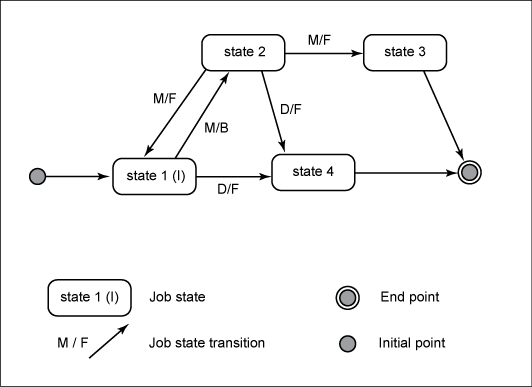The system table TB_JOB_STATE_TRANSITION stores the job state transition rules. You can define additional transition rules. Besides, you must do this at the beginning of all job configuration and data capture.
|
Attributes of TB_JOB_STATE_TRANSITION |
Description |
|
|
PREDECESSOR_ID |
Stores the foreign key to the previous state (TB_JOB_STATE) in the state diagram. |
|
|
SUCCESSOR_ID |
Stores the foreign key to the next state (TB_JOB_STATE) in the state diagram. |
|
|
TRANSITION_TYPE |
Specifies the value indicating what the software must do when the state transition is executed.
|
|
|
TRANSITION_DIRECTION |
Specifies the value indicating whether the transition is made forward (F) or backward (B). Example: A forward transition could be a merge process (open -> pending). A backward transition could be an undo of a merge process (pending -> open). |
|
A transition type with D for delete can never be backward.
The following table shows the default job state transition rules:
|
ID |
Predecessor |
Successor |
Direction |
Type |
|
1 |
Open (3) |
Pending (2) |
Forward (F) |
Merge (M) |
|
2 |
Pending (2) |
Open (3) |
Backward (B) |
Merge (M) |
|
3 |
Pending (2) |
Live (1) |
Forward (F) |
Merge (M) |
|
4 |
Open (3) |
Deleted (4) |
Forward (F) |
Delete (D) |
|
5 |
Pending (2) |
Deleted (4) |
Forward (F) |
Delete (D) |

Job states and job state transitions. The direction of a transition can be forward F or backward B. M merges the features.
The initial point can only have one initial state as successor. There can only be one initial state.